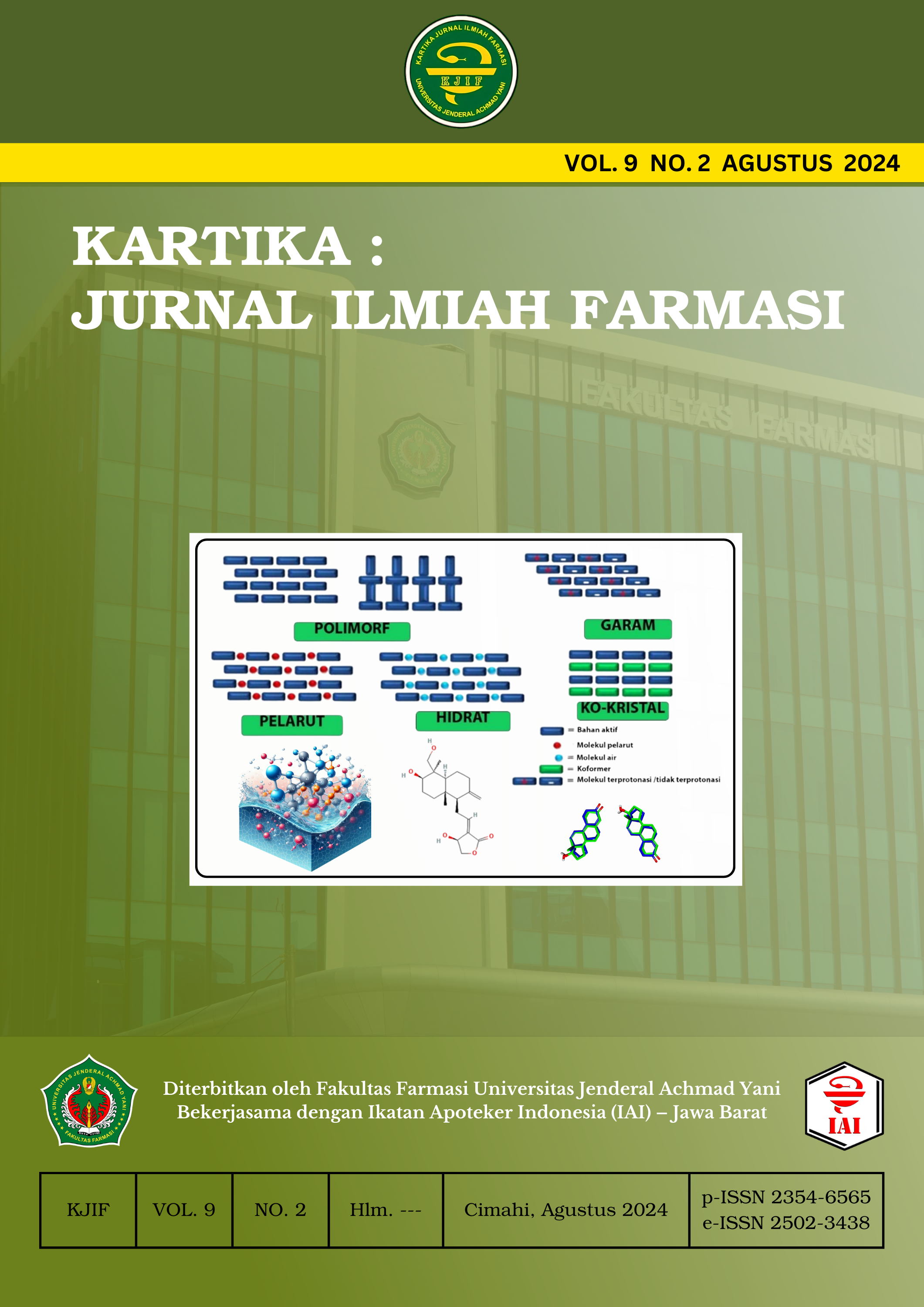PENANGANAN PERMASALAHAN SIFAT HIGROSKOPIS PADA FORMULASI SEDIAAN TABLET
DOI:
https://doi.org/10.26874/kjif.v9i2.728Abstrak
Sebagian besar bahan aktif farmasi (BAF) bersifat sangat higroskopis dalam bentuk padatan. Higroskopisitas yang tinggi dapat menimbulkan beberapa permasalahan antara lain terjadinya perubahan sifat fisikokimia pada bahan aktif. Perubahan sifat fisiko kimia tersebut dapat berdampak pada usia simpan sediaan tablet sehingga menjadi lebih singkat. Kajian literatur ini bertujuan untuk memberikan informasi mengenai penanganan pada proses produksi sediaan tablet yang memiliki sifat padatan bahan baku higroskopis. Metode penyusunan kajian literatur ini bersumber dari 42 artikel yang berasal dari artikel jurnal nasional maupun internasional yang telah terbit pada sepuluh tahun terakhir (2014-2024), artikel yang terkumpul dilakukan seleksi dan identifikasi berdasarkan kriteria inklusi dan eksklusi. Hasil kajian penelusuran pustaka terkait dengan upaya yang dapat dilakukan dalam penanganan permasalahan sifat higroskopis padatan farmasi pada formulasi sediaan tablet, antara lain yaitu, dengan teknik penyalutan film, teknik enkapsulasi (dengan spray-drying/freeze-drying dan koaservasi kompleks), teknik ko-proses (co-process), dan rekayasa kristal (co-crystal). Berdasarkan kajian literatur yang telah dilakukan dapat disimpulkan bahwa beberapa teknik dalam memodifikasi sifat fisik bahan aktif farmasi pada formulasi sediaan tablet dapat menangani permasalahan sifat higroskopis bahan aktif dengan meningkatkan pengendalian higroskopisitas suatu padatan sehingga dapat meningkatkan stabilitas bahan aktif.
Kata kunci: Formulasi, higroskopis, penanganan, sediaan, tablet.
Abstract
The majority of active pharmaceutical ingredients (API) are highly hygroscopic in solid form. High hygroscopicity can cause several problems, including changes in the physicochemical properties of active ingredients which can cause difficulties in formulating a preparation such as tablets, so that this can affect the shelf life of tablet preparations which become shorter. This literature review aims to find out the formulation handling in the production process of tablet preparations that have the characteristics of highly hygroscopic solids. The method of preparing this literature review comes from 42 articles originating from national and international journal articles that have been published in the last ten years (2014 - 2024), the collected articles were selected and identified based on the inclusion and exclusion criteria. The results of the literature search review related to efforts that can be made in handling the problem of hygroscopic properties of pharmaceutical solids in tablet dosage formulations, including film coating techniques, encapsulation techniques (by spray-drying/freeze-drying and complex coacervation), co-process techniques, and crystal engineering (co-crystal). Based on the literature review that has been conducted, it can be concluded that several techniques in modifying the physical properties of active pharmaceutical ingredients in tablet formulations can handle the problem of the hygroscopic nature of active ingredients by increasing the control of hygroscopicity of a solid so as to increase the stability of active ingredients.
Keywords: Formulation, hygroscopic, handling, preparation, tablets.
Referensi
Aguilar-Toala, J.E., Quintanar-Guerrero, D., Liceaga, A.M., and Zambrano- Zaragoza, M.L., 2022. Encapsulation of bioactive peptides: A strategy to improve the stability, protect the nutraceutical bioactivity and support their food applications. RSC Advances, 12 (11), 6449–6458.
Anbarasan, A., Nataraj, J., Shanmukhan, N., and Radhakrishnan, A., 2019. Effect of Hygroscopicity on Pharmaceutical Ingredients, Methods to Determine and Overcome: An Overview. J. Pharm. Sci. & Res., 11 (1), 6–10.
Apeji, Y.E., Kaigama, R.T., Ibrahim, S.H., Anyebe, S.N., Abdussalam, A.O., and Oyi, A.R., 2022. Tableting Performance of Maize and Potato Starches Used in Combination as Binder/ Disintegrant in Metronidazole Tablet Formulation. Turkish Journal of Pharmaceutical Sciences, 19 (5), 513–520.
Ficzere, M., Mészáros, L.A., Kállai-Szabó, N., Kovács, A., Antal, I., Nagy, Z.K., and Galata, D.L., 2022. Real-time coating thickness measurement and defect recognition of film coated tablets with machine vision and deep learning. International Journal of Pharmaceutics, 623 (April).
Frent, O.D., Vicas, L.G., Duteanu, N., Morgovan, C.M., Jurca, T., Pallag, A., Muresan, M.E., Filip, S.M., Lucaciu, R.L., and Marian, E., 2022. Sodium Alginate—Natural Microencapsulation Material of Polymeric Microparticles. International Journal of Molecular Sciences, 23 (20), 12108.
Fu, M., Blechar, J.A., Sauer, A., Al-Gousous, J., and Langguth, P., 2020. In vitro evaluation of enteric-coated hpmc capsules—Effect of formulation factors on product performance. Pharmaceutics, 12 (8), 1–17.
Guo, C., Zhang, Q., Zhu, B., Zhang, Z., Ma, X., Dai, W., Gong, X., Ren, G., and Mei, X., 2020. Drug-Drug Cocrystals Provide Significant Improvements of Drug Properties in Treatment with Progesterone. Crystal Growth and Design, 20 (5), 3053–3063.
Guo, M., Sun, X., Chen, J., and Cai, T., 2021. Pharmaceutical cocrystals: A review of preparations, physicochemical properties and applications. Acta Pharmaceutica Sinica B, 11 (8), 2537–2564.
Gupta, M.M., Chatterjee, A., and Kumawat, T., 2023. Troubleshooting the Poor Flow Problem of Valsartan Drug Powder Using the Crystallo-Co-Agglomeration Technique. Cureus, 2023 (5), 1–6.
Himawan, A., Anjani, Q.K., Detamornrat, U., Vora, L.K., Permana, A.D., Ghanma, R., Naser, Y., Rahmawanty, D., Scott, C.J., and Donnelly, R.F., 2023. Multifunctional low temperature-cured PVA/PVP/citric acid-based hydrogel forming microarray patches: Physicochemical characteristics and hydrophilic drug interaction. European Polymer Journal, 186 (October 2022), 111836.
Hussain, S.A., Abdelkader, H., Abdullah, N., and Kmaruddin, S., 2018. Review on micro-encapsulation with Chitosan for pharmaceuticals applications. MOJ Current Research & Reviews, 1 (2), 77–84.
Jain, S., Kaur, S., Rathi, R., Nagaich, U., and Singh, I., 2023. Application of co-processed excipients for developing fast disintegrating tablets: A review. Polymers in Medicine, 53 (1), 59–68.
Jeganathan, B., Prakya, V., and Deshmukh, A., 2016. Preparation and Evaluation of Diclofenac Sodium Tablet Coated with Polyelectrolyte Multilayer Film Using Hypromellose Acetate Succinate and Polymethacrylates for pH-Dependent, Modified Release Drug Delivery. AAPS PharmSciTech, 17 (3), 578–587.
Ji, R., Cui, H., Duhoranimana, E., Hayat, K., Yu, J., Hussain, S., Usman Tahir, M., Zhang, X., and Ho, C.T., 2021. Co-encapsulation of L-ascorbic acid and quercetin by gelatin/sodium carboxymethyl cellulose coacervates using different interlayer oils. Food Research International, 145 (April), 110411.
Jiang, S.L., Papageorgiou, L.G., Bogle, I.D.L., and Charitopoulos, V.M., 2022. Investigating the Trade-Off between Design and Operational Flexibility in Continuous Manufacturing of Pharmaceutical Tablets: A Case Study of the Fluid Bed Dryer. Processes, 10 (3), 454.
Khadka, P., Ro, J., Kim, H., Kim, I., Kim, J.T., Kim, H., Cho, J.M., Yun, G., and Lee, J., 2014. Pharmaceutical particle technologies: An approach to improve drug solubility, dissolution and bioavailability. Asian Journal of Pharmaceutical Sciences, 9 (6), 304–316.
Koumbogle, K., Gosselin, R., Gitzhofer, F., and Abatzoglou, N., 2023. Moisture Behavior of Pharmaceutical Powder during the Tableting Process. Pharmaceutics, 15, 1652.
Li, P., Zhang, G., Zhou, Z., Sun, Y., Wang, Y., Yang, Y., and Zhang, X., 2024. The Effect of Solvents on the Crystal Morphology of Isosorbide Mononitrate and Its Molecular Mechanisms. Molecules, 29 (2), 367.
El Mabrouki, H. and Kaukhova, I.E., 2022. Formulation and Development of Aqueous Film Coating for Moisture Protection of Hygroscopic Herniaria glabra L. Tablets. Turkish Journal of Pharmaceutical Sciences, 19 (2), 153–160.
Malaki, M. and Varma, R.S., 2023. Wetting of MXenes and Beyond. Nano-Micro Letters, 15 (1), 1–13.
Markwalter, C.E. and Prud’homme, R.K., 2018. Design of a Small-Scale Multi-Inlet Vortex Mixer for Scalable Nanoparticle Production and Application to the Encapsulation of Biologics by Inverse Flash NanoPrecipitation. Journal of Pharmaceutical Sciences, 107 (9), 2465–2471.
Mikhailov, E.F. and Vlasenko, S.S., 2020. High-humidity tandem differential mobility analyzer for accurate determination of aerosol hygroscopic growth, microstructure, and activity coefficients over a wide range of relative humidity. Atmospheric Measurement Techniques, 13 (4), 2035–2056.
Ng, L.H., Ling, J.K.U., and Hadinoto, K., 2022. Formulation Strategies to Improve the Stability and Handling of Oral Solid Dosage Forms of Highly Hygroscopic Pharmaceuticals and Nutraceuticals. Pharmaceutics, 14, 2025.
Nyamweya, N.N., 2021. Applications of polymer blends in drug delivery. Future Journal of Pharmaceutical Sciences, 7 (1).
Patel, P., Dave, A., Vasava, A., and Patel, P., 2015. Formulation and characterization of sustained release dosage form of moisture sensitive drug. International Journal of Pharmaceutical Investigation, 5 (2), 92.
Penhasi, A., Elias, M., Eshtauber, E., Naiman-Nissenboim, H., Reuveni, A., and Baluashvili, I., 2017. A novel hybrid solid dispersion film coat as a moisture barrier for pharmaceutical applications. Journal of Drug Delivery Science and Technology, 40 (May), 105–115.
Piñón-Balderrama, C.I., Leyva-Porras, C., Terán-Figueroa, Y., Espinosa-Solís, V., Álvarez-Salas, C., and Saavedra-Leos, M.Z., 2020. Encapsulation of active ingredients in food industry by spray-drying and nano spray-drying technologies. Processes, 8 (8), 889.
Rashid, A., Khalid, S.H., Irfan, M., Asghar, S., Rizg, W.Y., Sabei, F.Y., Alfayez, E., Alkharobi, H., Safhi, A.Y., Hosny, K.M., Arshad, M.S., and Khan, I.U., 2023. In Vitro and In Vivo Evaluation of Composite Oral Fast Disintegrating Film: An Innovative Strategy for the Codelivery of Ranitidine HCl and Flurbiprofen. Pharmaceutics, 15 (7), 1987.
Roy, S., Siddique, S., Majumder, S., Abdul, M.I.M., Ur Rahman, S.A., Lateef, D., Dan, S., and Bose, A., 2018. A systemic approach on understanding the role of moisture in pharmaceutical product degradation and its prevention: Challenges and perspectives. Biomedical Research (India), 29 (17), 3336–3343.
Sakhiya, D.C. and Borkhataria, C.H., 2024. A review on advancement of cocrystallization approach and a brief on screening, formulation and characterization of the same. Heliyon, 10 (7), e29057.
Santos, D., Maurício, A.C., Sencadas, V., Santos, J.D., Fernandes, M.H., and Gomes, P.S., 2018. Spray Drying: An Overview. In: Biomaterials - Physics and Chemistry - New Edition. 1–36.
Seo, K.S., Bajracharya, R., Lee, S.H., and Han, H.K., 2020. Pharmaceutical application of tablet film coating. Pharmaceutics, 12 (9), 1–20.
Shinozaki, T., Ono, M., Higashi, K., and Moribe, K., 2019. A Novel Drug-Drug Cocrystal of Levofloxacin and Metacetamol: Reduced Hygroscopicity and Improved Photostability of Levofloxacin. Journal of Pharmaceutical Sciences, 108 (7), 2383–2390.
Singh, M., Barua, H., Jyothi, V.G.S.S., Dhondale, M.R., Nambiar, A.G., Agrawal, A.K., Kumar, P., Shastri, N.R., and Kumar, D., 2023. Cocrystals by Design: A Rational Coformer Selection Approach for Tackling the API Problems. Pharmaceutics, 15 (4), 1161.
Timilsena, Y.P., Akanbi, T.O., Khalid, N., Adhikari, B., and Barrow, C.J., 2019. Complex coacervation: Principles, mechanisms and applications in microencapsulation. International Journal of Biological Macromolecules, 121 (1), 1276–1286.
Veronica, N., Liew, C.V., and Heng, P.W.S., 2020. Insights on the role of excipients and tablet matrix porosity on aspirin stability. International Journal of Pharmaceutics, 580 (March), 119218.
Wasilewska, K. and Winnicka, K., 2019. Ethylcellulose-a pharmaceutical excipient with multidirectional application in drug dosage forms development. Materials, 12 (20), 3386.
Watanabe, T., Ito, M., Suzuki, H., Terada, K., and Noguchi, S., 2021. Reduced deliquescency of isosorbide by cocrystallization and mechanisms for hygroscopicity. International Journal of Pharmaceutics, 607 (April), 120959.
Xie, Y., Gong, L., Tao, Y., Zhang, B., Zhang, L., Yang, S., Yang, D., Lu, Y., and Du, G., 2024. New Cocrystals of Ligustrazine: Enhancing Hygroscopicity and Stability. Molecules, 29 (10), 1–16.
Yang, Q., Ma, Y., Zhu, J., Chow, K., and Shi, K., 2017. An update on electrostatic powder coating for pharmaceuticals. Particuology, 31, 1–7.
Yang, Q., Yuan, F., Xu, L., Yan, Q., Yang, Y., Wu, D., Guo, F., and Yang, G., 2019. An update of moisture barrier coating for drug delivery. Pharmaceutics, 11 (9).
Zheng, X., Wu, F., Hong, Y., Shen, L., Lin, X., and Feng, Y., 2019. Improvements in sticking, hygroscopicity, and compactibility of effervescent systems by fluid-bed coating. RSC Advances, 9 (54), 31594–31608.
##submission.downloads##
Diterbitkan
Cara Mengutip
Terbitan
Bagian
Lisensi
Hak Cipta (c) 2024 Kartika : Jurnal Ilmiah Farmasi

Artikel ini berlisensi Creative Commons Attribution-NonCommercial 4.0 International License.
Penulis yang menerbitkan artikel pada jurnal ini menyetujui ketentuan berikut:
- Penulis memberikan hak cipta dan jaminan atas artikel sebagai publikasi pertama, yang memberikan kesempatan pada orang lain untuk membagi artikel dibawah lisensi Creative Commons Attribution License
- Penulis dapat melakukan perubahan dan menambahkan untuk pendistribusian artikel yang terpublikasi secara non eksklusif (misalnya, mempostingnya ke repositori institusional atau mempublikasikannya dalam sebuah buku), dengan pengakuan publikasi awal dalam jurnal ini.
- Penulis diizinkan dan didorong untuk memposting pekerjaan mereka secara online (misalnya, di repositori institusional atau di situs web mereka) sebelum dan selama proses pengajuan, karena dapat mengarah pada pertukaran produktif, serta kutipan pekerjaan sebelumnya dan lebih besar yang diterbitkan (Lihat The Effect of Open Access).























